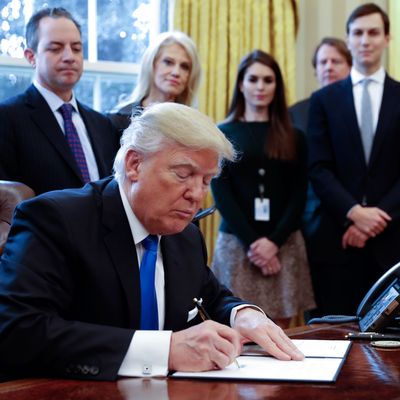
Donald Trump began his presidency with a blitzkrieg of delusional lies and reactionary edicts. As the president’s mouth laid waste to the concept of objective truth — and his pen tore through Obamacare, abortion rights, sanctuary cities, environmental protection, the fragile hopes of refugees, and, quite possibly, the United Nations — liberals stared slack-jawed at their screens, wishing this was all just some nightmarish reality show.
And, in a sense, it actually may be.
Trump is an expert in spectacle, not governance. Since November 8, he has applied that expertise relentlessly. As president-elect, he cut down on government waste by tweeting angry demands at Lockheed Martin over Twitter — and protected American jobs by presenting corporate-expansion plans drafted before his election as products of his own genius.
These moves were fairly easy to identify as acts of theater, not policy. Once Trump started signing leather-bound documents in the White House, however, it was hard to see the president’s actions as mere photo ops — no matter how many cameras had been crammed into the Oval Office.
But now, it appears those executive orders may have been all sound and fury — signifying more than nothing, but less than they appeared to.
Part of why Trump has been able to dash off executive orders at such a frenetic pace — even as the rest of his transition is woefully behind schedule — is that he has neglected to have them reviewed by relevant cabinet agencies, congressional committees, or legal counsel.
Rather, the documents have been drafted with the consultation of virtually no one but Breitbart mastermind Steve Bannon, and his fellow right-wing nationalist Stephen Miller, according to Politico.
And as it turns out, governing by Breitbart op-ed has its drawbacks. For example, Trump’s executive order on the Keystone XL was drafted without the consultation of the State Department, despite the fact that the company behind the pipeline is suing the U.S. for $15 billion — and aspects of the order could plausibly strengthen the company’s case: Among other things, the order requires any company building a pipeline to use materials manufactured domestically — a provision that may contravene various trade treaties that the U.S. is bound by.
Meanwhile, Trump’s much-ballyhooed order calling for the construction of a border wall — and a tripling of border-enforcement agents — cannot be executed without congressional appropriations that could prove hard to come by. Which is to say, the executive order does not fulfill Trump’s campaign promise, but merely reaffirms his commitment to fulfilling it. Further, Trump’s order stripping funding from sanctuary cities is a legally tendentious proposition, which the administration seems to have asked zero constitutional lawyers to weigh in on.
His order on the Affordable Care Act doesn’t appear to make any “tangible” policy changes, in the view of the Kaiser Family Foundation.
And then there are the drafted executive orders that Trump has yet to sign. One of these would reportedly require agencies to reconsider using interrogation techniques that had been banned as torture — an idea that Defense Secretary James Mattis and CIA Director Mike Pompeo were “blindsided” by, according to Politico. Another would cut U.S. funding to the International Criminal Court by 40 percent — even though the U.S. does not fund the International Criminal Court.
Ultimately, though, the president may care less about whether these executive orders are effective in policy terms, than if they play well in theatrical ones. Per Politico:
Trump, less than a week into his presidency, is continuing the improvisational style he used to run his company, his campaign and his transition. He’s relying on a small circle of trusted advisers to act decisively. And he’s emphasizing the theatrics of autographing official-looking leather-bound documents in the Oval Office.
People familiar with Trump’s planning say he wanted daily events to show supporters he would follow through on the items of his campaign agenda. “He was determined to show people that he’s getting to work from Day One,” one person familiar with his planning said. This person said he wanted to take charge and show his supporters that former President Barack Obama’s tenure was decisively over.
Meanwhile, the congressional GOP is camped out in Philadelphia, waiting for Trump to give them some hint of what his intentions are with regard to actual legislation. The Washington Post reports:
One question among House Republicans is how many of the recommendations within the official House GOP policy blueprint, “A Better Way,” Trump will also take up. Also unclear is how much leverage these Republican lawmakers will have to negotiate with a president who does not like dissent and regularly takes to cable news and Twitter to lash out at critics.
“He’s only been there a couple of days, I get it, but we do need to know this: Is he going to be with us when we go forward? Where does he stand on these issues?” said Rep. Roger Williams (R-Tex.). “There’s a lot of questions we need to ask him so we know where he is, so we don’t go out down the dirt road and he’s going on down the freeway.”
There are at least two ways of interpreting all this: Either Trump hopes to strong-arm the federal bureaucracy and Congress into realizing Steve Bannon’s wildest dreams — or he just wants to execute some well-staged photo-ops while Mike Pence does all that slow boring of hard boards.
Which is to say: Either Donald Trump is the president, or he just plays one on TV.






























